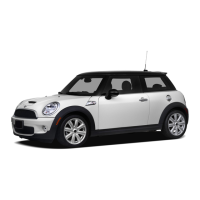tronics. In this case, have the electronics
checked and replaced at the next opportu-
nity.
Runflat tires
Safety information
Warning
The vehicle handles differently when a
runflat tire has insufficient or no tire pres-
sure; for instance, reduced directional sta-
bility when braking, braking distances are
longer and the self-steering properties will
change. There is a risk of accident. Drive
moderately and do not exceed a speed of
50 mph/80 km/h.
Maximum speed
You may continue driving with a damaged
tire at speeds up to 50 mph/80 km/h.
Continued driving with a flat tire
If continuing to drive with a damaged tire:
1. Avoid sudden braking and steering ma-
neuvers.
2. Do not exceed a speed of
50 mph/80 km/h.
3. Check the tire inflation pressure in all
four tires at the next opportunity.
If the tire pressure in all four tires is
correct, the Tire Pressure Monitor may
not have been reset. In this case, per-
form the reset.
Possible distance traveled with a
depressurized tire
The possible distance which may be safely
traveled varies depending on how the vehi-
cle is loaded and used, e.g., speed, road con-
ditions, outside temperature. The distance
traveled may be less but may also be more if
an economical driving style is used.
If the vehicle is loaded with an average
weight and used under favorable conditions,
the possible distance traveled may be up to
50 miles/80 km.
Vehicle handling with damaged tires
Vehicles driven with a damaged tire will
handle differently, potentially leading to
conditions such as the following:
– Greater likelihood of skidding of the ve-
hicle.
– Longer braking distances.
– Changed self-steering properties.
Modify your driving style. Avoid abrupt
steering maneuvers or driving over obsta-
cles, for instance curbs or potholes.
Final tire failure
Vibrations or loud noises while driving can
indicate the final failure of a tire.
Reduce speed and stop; otherwise, pieces
of the tire could come loose and cause an
accident.
Do not continue driving. Contact an author-
ized service center or another qualified
service center or repair shop.
System limits
Temperature
The tire inflation pressure depends on the
tire's temperature.
Driving or exposure to the sun will increase
the tire temperature, thus increasing the
tire inflation pressure.
The tire inflation pressure is reduced when
the tire temperature falls again.
These circumstances may cause a warning
when temperatures fall very sharply.
Seite 158
CONTROLS Safety
158
Online Edition for Part no. 01405A7DAD4 - II/23

